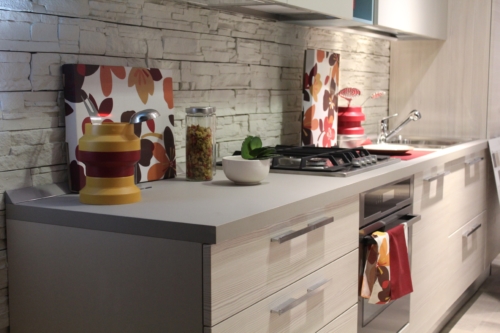Home base for most back-splashes is the kitchen, especially surrounding sinks and stoves. The back-splash protects the wall from water stains and damage—or, even marks from tools and gadgets that live on the counter.
Still, many creative locations make sense to add a back-splash, like in the bathroom, behind the toilet and sink and even surrounding the showers. There is even a trend of installing back-splashes on the ceiling to clearly define a shower alcove, and to prevent water damage!
1.) Color or Neutrals?
Color is usually one of the first decisions you’ll make. You’ll need to decide if you want your back-splash to be colorful, or if you want to remain in the neutral zone. Although a colorful back-splash has immediate impact, a neutral back-splash can add just as much character to your space.
2.) Backsplash Height
Back-splash height is often a design detail homeowners overlook. The back-splash has to end somewhere, but where it ends is up to you, although cabinetry can often be the deciding factor. If you just want a hint of tile, only bring your back-splash up to the bottom of your cabinet or first shelf in an open shelving design such as the one below.
3.) Material
The material you choose for your back-splash is just as important as color. You’ll need to figure out which tile type will work best in your overall design. Is it ceramic? Brick? Hand painted? This decision should be based on personal preference but also on the overall design style you are trying to achieve. If your kitchen is rustic or industrial, Brick might work best. If it is clean and contemporary, a crisp matte glaze from our ceramic Tile line will probably be your best bet.
4.) Consider Your Countertops
Your tile back-splash is always going to be right up against your countertops, so it is important to make sure the two materials and colors work well together. If you choose a colorful countertop material such as in the kitchen below you’ll want to choose a neutral tile color (but you can still go wild with pattern!). If your countertops are neutral, choose tile that complements the texture and tone of the countertop material.
5.) Shape and Pattern
Do you prefer classic shapes, or fun patterns?–Another important decision to be made. If you want your kitchen to remain timeless in design, we suggest sticking with a classic field tile size such as a 3×6 in a subway tile layout, or even a 4×4 in a straight set pattern. Field tile will transcend trends, making your tile back-splash a sustainable design feature.
Conclusion
Here at Saddleback Carpet & Flooring we have a large selection of tiles to choose from. Come by our showroom and pick out some samples and take them home to see how they will look in your space.
